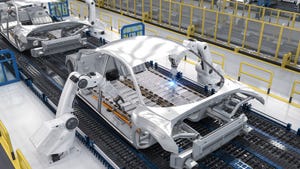The Annual Technology Baseline (ATB) provides researchers a consistent data set to build cost and consumption models.
September 23, 2021

Every year, a team of analysts from the U.S. Department of Energy’s (DOE) national laboratories integrates current and projected data for electricity-generation technologies into one user-friendly tool. It is led by the National Renewable Energy Laboratory (NREL) and the result is the Annual Technology Baseline (ATB).
Based on a Need
The ATB was created because there was no existing database with the level of nuance on technology innovation that energy analysts need. As a national laboratory dedicated specifically to renewable energy, NREL partners with Oak Ridge National Laboratory to dive into those nuances for renewable generation technologies. The challenge of aggregating energy data from different sources into studies is knowing whether the data uses consistent assumptions. The ATB resolves this challenge by creating consistent assumptions across all electric generation technology cost and performance data. Without the ATB, analysts would have to seek out data in many places and are likely to have inconsistent assumptions.
All renewable energy technologies are represented in the ATB. In this Q&A, solar power technology leads and NREL analysts—David Feldman, Chad Augustine, Parthiv Kurup, and Craig Turchi—share their insight on why the ATB is unique and what is new in terms of solar photovoltaics (PV) and concentrating solar power (CSP) in the 2021 update, including new technologies, expanded financial data, and better interoperability with other models.
Users
The ATB is useful for analysts and researchers who are trying to model the electric grid, or individual technologies, in the United States or internationally. The report covers cost and performance metrics that include upfront costs, operating costs, system performance, and financing costs for most technologies over a 30-year period. These values can be used to calculate a Levelized cost of energy (LCOE)—an important metric of comparison between electricity generation technologies—as well as other factors, such as the value of the energy.
Recently, the California Energy Commission and Cal-ISO [California System Operator] commissioned modelers to look at the future of their grid. They use the ATB for their model inputs to understand the impacts of policy with high renewables deployment. Internationally, organizations like the energy department in Chile have utilized the ATB costs in their scenarios and comparing them to costs in the market as a validation.
Solar Insights
Although all renewable energy technologies are represented in the ATB the current issue (July 2021) features the insights of solar power technology leads and NREL analysts David Feldman, Chad Augustine, Parthiv Kurup, and Craig Turchi on what is new in terms of solar photovoltaics (PV) and concentrating solar power (CSP), including new technologies, expanded financial data, and better interoperability with other models. They discuss CSP technology in the form of a molten salt power tower with two-tank thermal energy storage, which drives a Rankine steam cycle. The system uses molten sodium and potassium nitrate as the heat transfer fluid and the energy storage media.
For both PV and CSP, the NREL has expanded the resource classes so a larger representation of how these systems will perform throughout the United States has been provided. The most0-current ATB also has added cost and performance metrics for PV-plus battery storage. Previously, it had only had separate PV and battery storage costs, but there is an ever-growing number of PV systems that are coupled with battery storage in the United States, so the study includes costs for those systems this year. According to the NREL, “For both PV and CSP, we’ve expanded our resource classes so we have larger representation of how these systems will perform throughout the United States. We also do a better job this year of representing the ongoing operating costs of PV systems, including five new cost categories. That’s a big improvement.”
The ARTB has also been useful to spot trends in the cost and performance of solar technologies. “Generally, performance has increased, and cost has decreased, dramatically for PV and overall in CSP,” the NREL reports. “The ATB has shown us there are several paths forward for continued price reduction. In the Standard Scenarios studies, you can see that when price decreases, renewable energy can become a significantly larger share of U.S. electricity generation. When that happens, there is also a lot of opportunity for greater deployment of storage technologies.”
Kevin Clemens is a Senior Editor with Battery Technology.
About the Author(s)
You May Also Like





